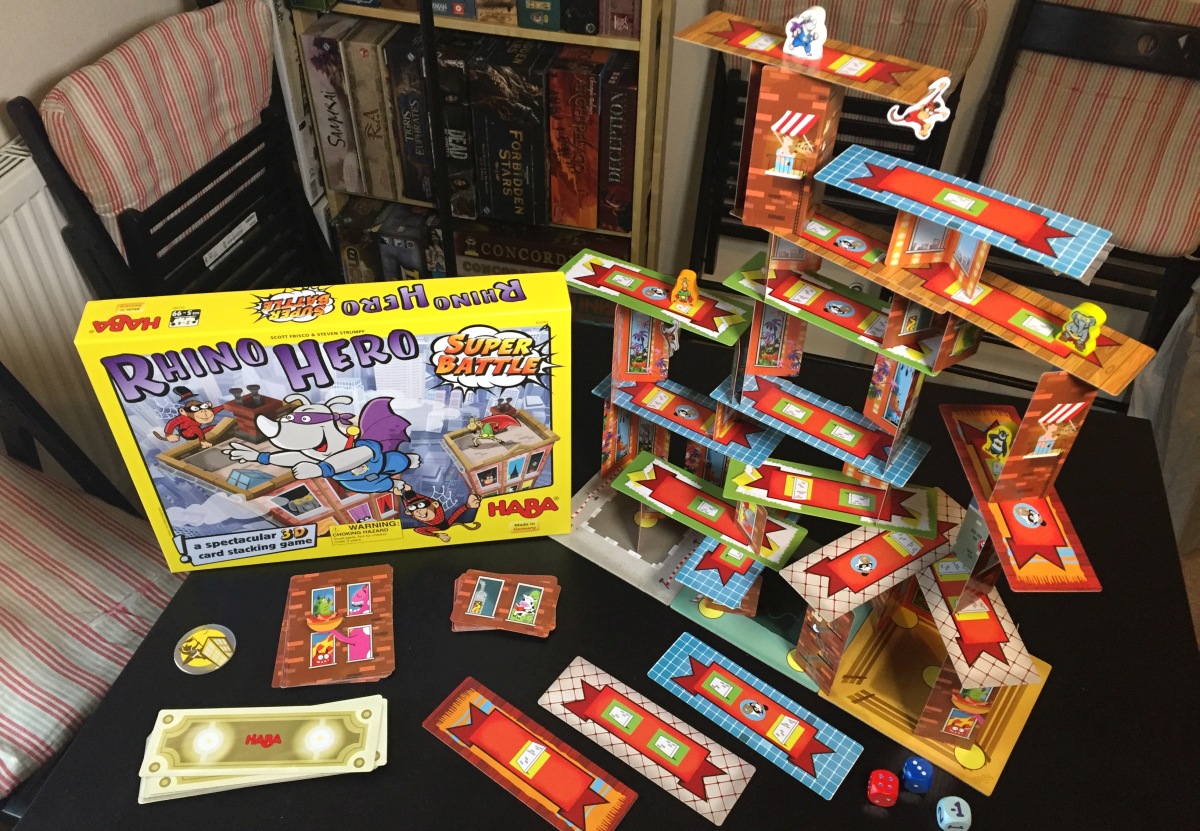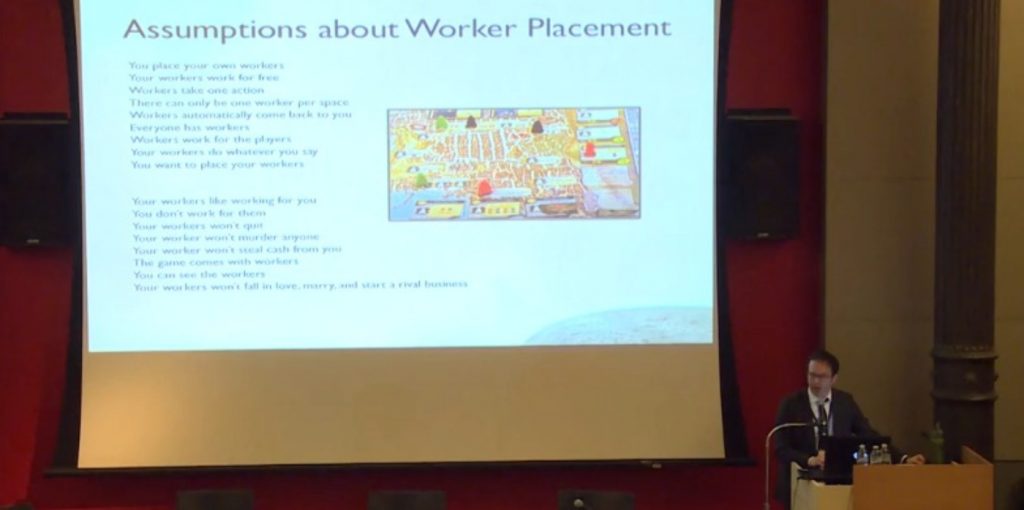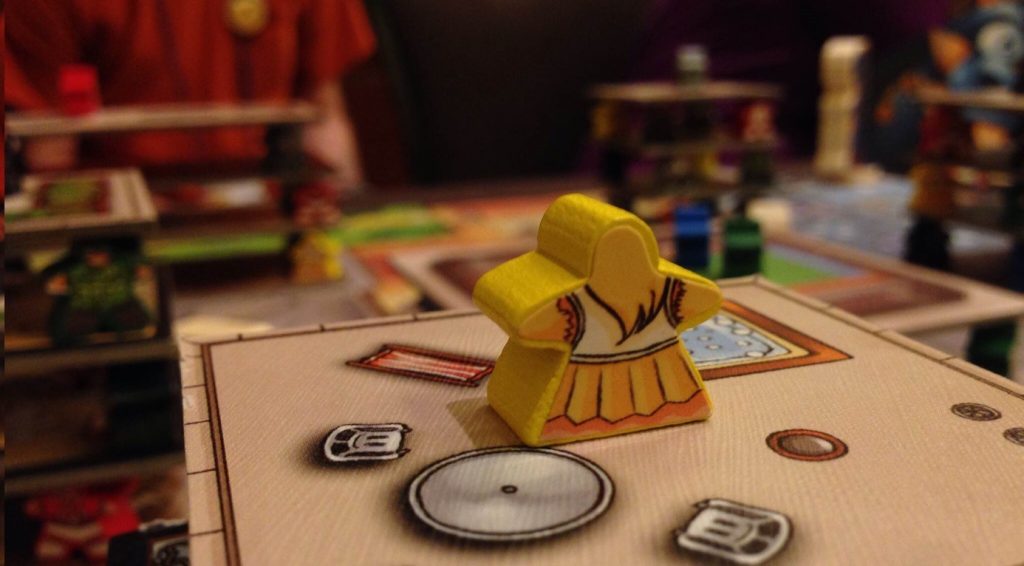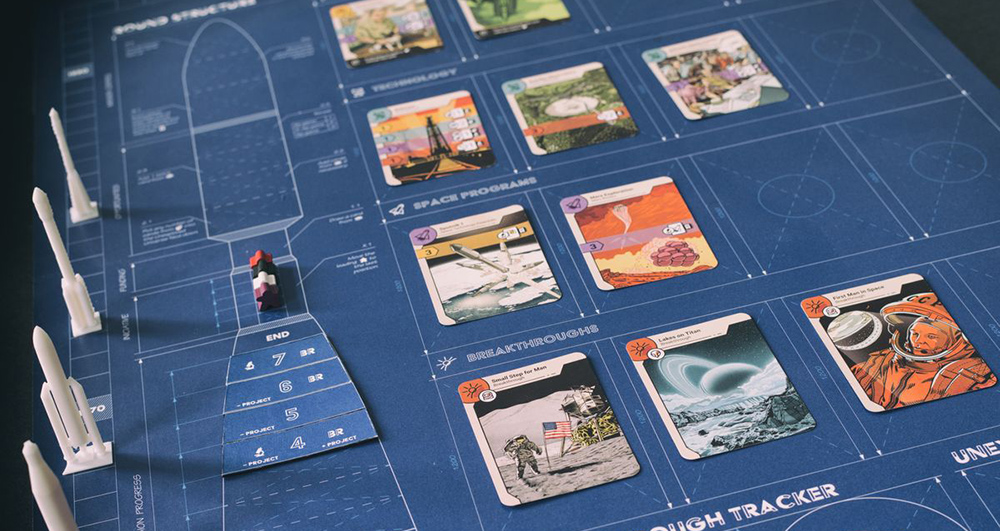Quinns: Leigh, thank you very much for agreeing to appear on Shut Up & Sit Down. I hope you won’t be expecting any special treatment as my wife.
Leigh: Not at all! It’s a pleasure to be invited to this forerunning venue for material game criticism.
Quinns: Do you think you’re up for the task?
Leigh: I certainly hope so!
Quinns: Glad to hear it. Today the text we’re looking at is Rhino Hero Super Battle, the outsize sequel to 2011 sleeper hit Rhino Hero. From the box – and I quote – “This time not only does the wobbly skyscraper need to be built & climbed, but there will also be fierce battles between the four superheroes Rhino Hero, Giraffe Boy, Big E. and Batguin.”
In more ways than one, Leigh, the world of Rhino Hero just got bigger.
Leigh: Wow. This sounds interesting. I particularly like how when you open the box, all the components are lying together, flat, unbent and unmarked. You’re looking, in a sense, at the modern urban concept in two dimensions.
And then, of course, we have the pieces that represent each of the “superheroes”, which I assume is a metaphor. I love when a standing-up cartoon animal is a metaphor. Although I wonder why only Rhino Hero is represented in the title of the work. Perhaps Giraffe Boy, Batguin and Big E. are all contenders for the title “hero”? Or are they all just manifestations of Rhino’s id?
Quinns: I wonder what it says that the “fierce battle” only takes place when we add the players to these components? As is so often the case, the audience is the proponent of darkness.
Leigh: That’s what I was thinking as well. If one expects this work to gradually introduce you to its themes as if lowering you into a warm bath of accessible concepts, think again: This game get right into the fragility of the urban home.
Quinns: And ask yourself this- why does ‘battling’ make you a hero?
One thing’s for sure, which is that Rhino Hero Super Battle is NOT for players aged five and over like the box suggests.
Leigh: Of course it’s only using the trappings of cartoonishness for juxtaposition. I’m a very serious critic of design, Quinns, and of interactive performance, and this is absolutely not a game for kids and is instead one where the cheer and charm is intended to comment on the insecurity of modern masculinity as well as the precarity of class.
Quinns: Let’s talk about “how” you “play”.
Leigh: Mmmm.
Quinns: 2-4 players in Rhino Hero Super Battle are tasked with building a skyscraper. Everyone holds three cards, which are in fact floors, and on your turn you select one to add to the building. The card you play will tell you which combination of short and tall walls you must add to the building before placing the card on top of them, and whether to hang any dangerous Spider Monkeys off of it.
Leigh: Yes. The Spider Monkeys constitute one of the major thematic twists in this narrative of structural ambition. When a card prescribes one of these monkeys, the player must hang the monkey, either by tail or paw, from the newly-constructed floor. This action risks the entire structural integrity of your city building, which summons some fascinating questions: Do the Spider Monkeys represent the proletariat who suffers in the face of increasingly scarce housing? Do the Spider Monkeys, dangling outside the windows of the merrily-illustrated, tea-sipping residents, remind us of the ways we turn a blind eye to those “left hanging” by the upward ambitions of capitalism?
Quinns: Yes. Also they’re dressed like Spider Man, which is a funny joke.
After adding their floor players then roll a special, chunky die (it almost looks like it’s designed for children, which is an interesting aesthetic choice) that tells you how many floors you must move your hero up (or down! there’s a -1 face on the die). Since the heroes are made of wood, this is a tense moment. If you arrive on the same floor as another player’s hero, you each roll a 6-sided die to determine who wins the battle, and the loser must (argh!) again pick up their wooden hero and move them one floor down.
At this point I should mention that the game specifically calls out the red die as the heroic defender’s die, whereas the squalid and unwholesome attacker, climbing up from below, must use the blue die. The red dice only shows even numbers, and the blue dice only shows odd numbers. But more importantly, the red die has glitter on its pips.
Leigh: The red die suggests communism could be the ‘heroic force’ that causes our fragile paper fantasies of wealth and mobility to tremble? Or is the glitter meant to summon the distracting spectre of lucre? There are so many ways you can read this work, as glossy “houses of cards”, both literally and symbolically, spring up all around you, inviting you to look inside. It’s a Hitchcockian Rear Window of themes.
Quinns: I couldn’t agree more. Finally, if you are the highest hero on the building you end your turn by claiming the prestigious Superhero medal, which is how you win the game. Whoever’s holding the medal when someone causes this increasingly unsteady skyscraper to fall down? They’re the winner.
Leigh: Does this not, fascinatingly, engender an environment whereby the dominant player — the one holding the symbolic “medal”, which surely comments on our addiction to achievement and perhaps even military goals — is incentivized to disrupt competition from other players? Does it model the inherent corruption society is doomed to embrace?
Quinns: Great point my love and wife. But if the medal-holder collapses the building, everybody else wins.
Leigh: Ah. Amazing. That’s very affecting. Destruction sacrifices the victory of the individual. When the individual victory is meaningless, the collective truly benefits.
Quinns: So did you have fun?
Leigh: That’s the truly revolutionary thing about this work — its design is in the service of fun. I can easily imagine children savaging the ruleset, rules be damned, and merely building, folding, crafting these colorful and zany representations of the urban housing crisis, because the materials themselves are a pleasure.
Quinns: Yes! It’s true that we’ve been spoiled for choice for good dexterity games recently. Flick ‘Em Up is a startlingly pretty cowboy game. Junk Art is far more thoughtful, but just as good. Go Cuckoo (also from HABA, publishers of Rhino Hero) is a small game that is so much more than the sum of its sticks.
With competitors like these, I wasn’t expecting Rhino Hero Super Battle to stand up. But it does stand up, and not just because it’s only £20. It stands up for the same reason that humans have been standing up houses of cards for hundreds of years, but gives that act colour, and – well – structure.
Like the original Rhino Hero, this game has a joy to it because building with cards is stable and wobbly at the same time, leading to a delightful illusion that OHMYGOSH ITSGOINGTOCOLLAPSE… but it stays standing.
Though actually, there’s a heck of a lot more to it than that. When you’re not at the top of the tower you’ll want to throw tall walls upwards, perhaps letting you scramble upwards past the highest player, avoiding a fight, but you never want to build so ambitiously that you collapse the tower. And likewise, you want to hold constructive “short wall” cards for when you’re already the top, though you don’t want to build so slow that your friends overtake you. A lot of people mistake dexterity games for simple games just because they’re simple to learn. In truth, there’s actually a ton of creativity and wit involved in placing cards securely.
There’s also joy in the fact that you’re building something so impressive and colourful together with your friends, and in getting to ‘climb’ this silly complex with your miniatures, which brings it to life. Plus, the “king of the hill” structure of staying on top and kicking one another back down again is just awesome. It activates the King Kong part of your brain. You’re above your friends, who must find a safe place to stash their hero on the crowded cards below.
Leigh: Yes! But while my trembling thumb often threatened the edge of some structure or another, I actually never felt anxious. In fact, I often built conservatively to avoid threat — which I do hope sends a message to the aggressive real estate firms ruthlessly gentrifying our cities. The core ‘mechanic’ was so gentle I felt myself longing, eventually, to disrupt even my own buildings in the hopes of generating some sort of impact. The urge to sabotage awakes in all of us eventually. It’s just a matter of how many floors stand between you and the lust for collapse.
Quinns: Right? But that’s part of the fun, too. If you want to build dangerously, you can, and the game rewards you for it. But if you want to build securely, and trust other people to screw up? That’s fine too.
To cap it all off (trembling fingers place a final, swaying roof…) we should mention that tweaking the difficulty of Rhino Hero Super Battle is as simple as flipping over the foundation tiles. Either you can give yourself a strong foundation, with lots of points you’re allowed to build off of….
…Or you can force players to build upwards sharply, with very few support struts:
The horror!
Leigh: Just wonderful. To make it so the players themselves must take the measure and depth of the vast socioeconomic challenge before them.
With a thumbnail you must fold. You must corrupt a flawless, shiny card with a sharp crease. But without such a gesture, your foundation has no corner. You must injure in order to create. And confronting these aspects of oneself is truly delightful. The creatures of this fictional city remind us of the importance of play, and how through play we model our beliefs about how best to live in close proximity to one another. Must we regard the social order? Or may we surrender to a silly skyline of kitty-corner cardstock apartment towers, full of kitties playing cards, themselves playing, playing life?
Beautiful work. A triumph.
Quinns: Do you still think the rhino is the cutest piece?
Leigh: Well. I do wish that Rhino Hero and his colleagues had their ‘avatars’ printed on both sides of their wooden play pieces. On his face the hero is substantial, but from behind, a formless cloud. Maybe this is intentional, remarking upon the duality of heroism, or how the self becomes incorporeal when oriented toward violence.
But yeah. He’s definitely the cutest! Look at him, he’s like, raring to go! I love Rhino Hero!
Quinns: Shut Up & Sit Down recommends Rhino Hero Super Battle to anyone. It’s super-sized, dizzying fun at a great price. I’m just sat here praying that this series will continue to grow, and I’ll get to review Rhino Hero: Super Battle: The Gigaplex in 2021. Thanks a lot for your help Leigh.
Leigh: It’s been a real pleasure. Thanks, Quinns!













